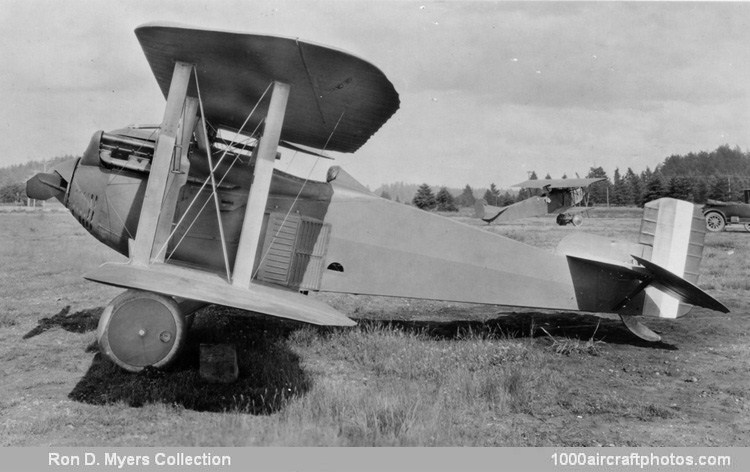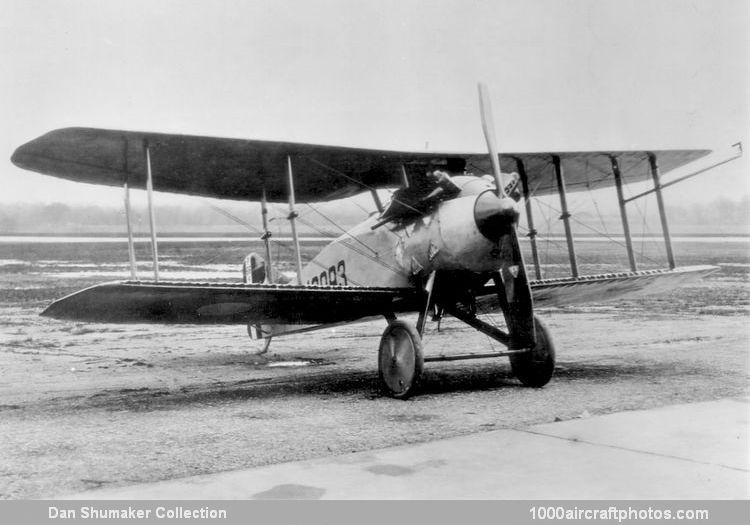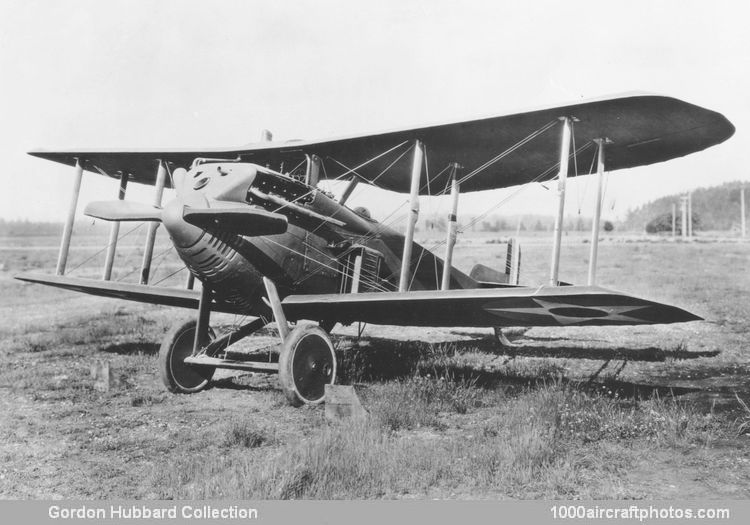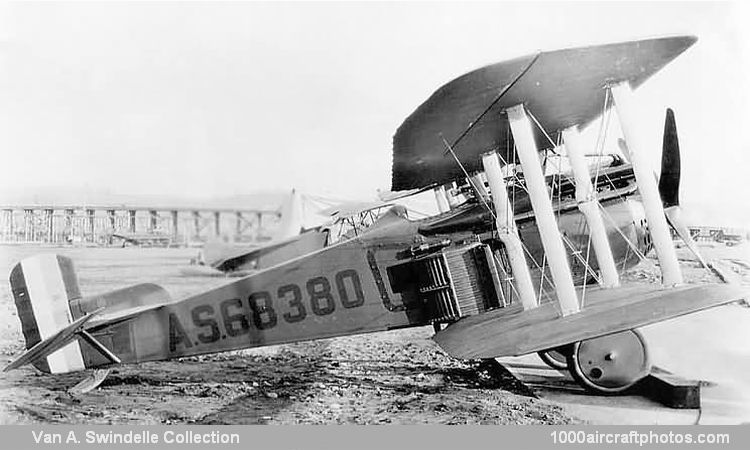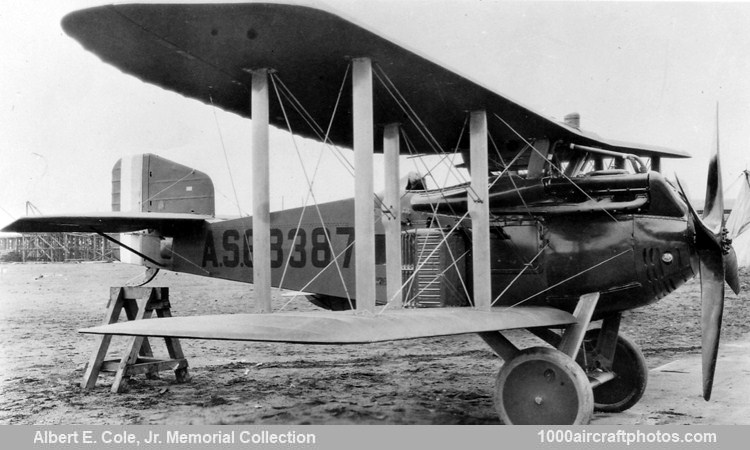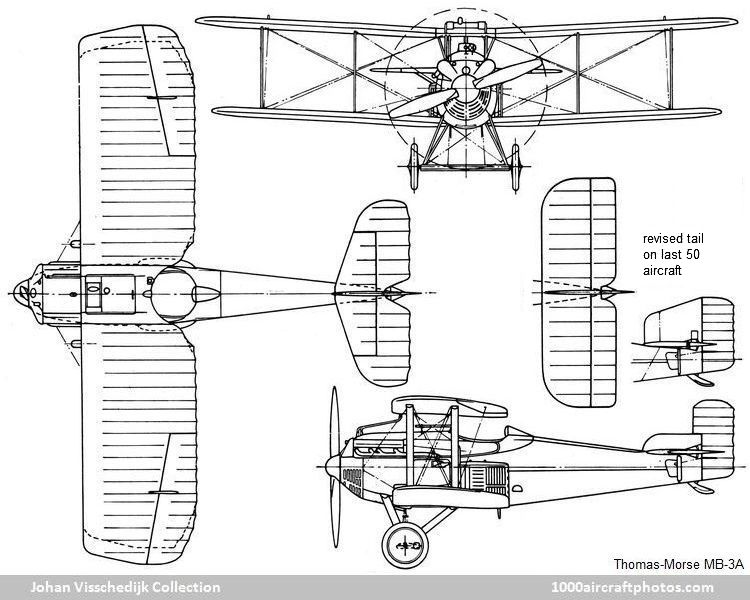RON D. MYERS COLLECTION
No. 13186. Thomas-Morse MB-3A (68237 c/n 210) US Army Air Service
03/31/2022. Remarks by
Johan Visschedijk: "In 1918, the Thomas-Morse Aircraft Corporation at Ithaca, New York, was invited to design a new single-seat fighter, superior to the latest SPAD models, around the 300hp Wright H license-built Hispano-Suiza eight-cylinder liquid-cooled V-engine.
Designed by William T. Thomas, the all-wooden aircraft was entirely conventional with a one-piece upper wing and two separate lower sections with solid spruce spars. Ailerons were fitted to the upper wing only which accommodated a radiator and a 3 gal (11.4 l) gravity fuel tank and featured a large cut-away section to enable the pilot access to a very cramped cockpit. Space was so limited that there was no room for a panel for instruments and these were scattered around wherever space could be found. Two other fuel tanks were placed in the fuselage, one of 18 gal (68.1 l) capacity forward of the pilot and one 20 gal (75.7 l) under the rudder bar. Two 0.30 in (7.62 mm) Marlin machine guns were mounted beneath a turtle-deck cowling.
Four prototypes (s/n 40092 to 40095) were ordered in September 1918 and the first of these flew at Ithaca on February 21, 1919, achieving a speed of 168 mph (270 kmh) and climbing to 10,000 ft (3,048 m) in 4 min 52 sec – claimed as an unofficial world record for Service-type aircraft. Shipped to the US Army Air Service's Engineering Division at McCook Field, Dayton, Ohio, for static testing, 40092 did not fly again.
Thomas-Morse MB-3 (40093
"P-66") (
Dan Shumaker Collection)
The other three prototypes were assigned McCook Field Project Numbers by the Flight Test Section: 40093
"P-66" (cannibalized for parts after 1921), 40094
"P-124" (damaged in transit and returned to factory for repairs, crashed 30 March, 1921), and 40095
"P-121" (survived until October 1926).
Although the McCook pilots found the MB-3 easy to taxi and the flight characteristics generally favorable, they reported that the pilot's view in the air was poor and the cockpit was far too small. Maintenance was a severe problem, the radiator gave trouble, as did the complicated fuel system. Also, the airframe suffered badly from engine vibration. In response to these criticisms, several modifications were made to 40095. The cockpit was lengthened (but not widened), the radiator was moved slightly to the right of the center line to allow for a larger 12 gal (45.4 l) gravity fuel tank, and structural strengthening increased the empty weight by 130 lb (59 kg).
In this revised form, together with a cut-down vertical fin, the Army ordered fifty production MB-3s (s/n 63331 to 63380) from Thomas-Morse on June 19, 1920, which were delivered from November. Four production aircraft had Project Numbers allotted (63332 -
"P-164"; 63336 -
"P-197"; 63338 -
"P-201"; 63337 -
"P-208") and were tested at McCook, they had to develop further improvements including more structural reinforcement and a revised cooling system with radiators each side of the cockpit instead of one on the upper wing.
Thomas-Morse MB-3A (68237) (
Gordon Hubbard Collection)
A contract for two hundred MB-3As (s/n 68237 to 68436, c/n 210 to 409) with the above revisions plus an armament of one 0.30 in (7.62 mm) and one 0.50 in (12.7 mm) Browning machine gun was given to Boeing in April 1921 which had underbid Thomas-Morse (and four other manufacturers) under the competitive bidding system then prevailing. It was the largest contract for pursuit fighters awarded until 1937. One pattern aircraft (s/n 63332) was sent to Boeing but crashed on landing at Seattle.
Thomas-Morse MB-3A with fuselage side radiators (
Van Swindelle Collection)
The Boeing-built MB-3As were fitted with a more efficient fuselage side radiators, which were built by Thomas-Morse. The first Boeing-built MB-3A (s/n 68237) was flown at Camp Lewis on 7 June, 1922, and on landing, ran through a small ditch and overturned. All aircraft were delivered between July 29 and December 27, 1922. Two and four-bladed propellers, the latter an attempt to reduce vibration, were used interchangeably on the MB-3A.
Thomas-Morse MB-3A (68387) with revised tail (
Albert Cole Memorial Collection)
The last fifty of Boeing's order (s/n 68387 to 68436) had redesigned tail surfaces with the fin area more than doubled (a feature tested on 68237 -
"P-259" at McCook). One model was built with special wings using four ailerons.
After replacement in front-line service by Boeing MB-3As, some MB-3s were rebuilt by Fairfield Air lntermediate Depot (F.A.L.D.) and redesignated MB-3M they were sent to Kelly Field, Texas, where they were used as advanced trainers by the 43rd School Squadron and were finally withdrawn from use in 1929. Several, destined for the junk pile, were used as German fighters for crash scenes in the air-war film 'Wings', most of the flying sequences being taken near Kelly Field with USAAS co-operation.
The MB-3 and MB-3A were both used for air racing, starting in 1920 when Capt. Harold E. Hartney was placed second in the Pulitzer Trophy Race in a prototype MB-3 (race number 41). Another prototype MB-3 (race number 43) was entered by Lt. Leigh Wade but had to retire after the first lap. USAAS use of the MB-3 in the races continued until 1923.
The other three prototypes were assigned McCook Field Project Numbers by the Flight Test Section, 40093
"P-66" (cannibalised for parts after 1921), 40094
"P-124" (damaged in transit and returned to factory for repairs, crashed 30 March, 1921), and 40095
"P-121" (survived until October 1926).
